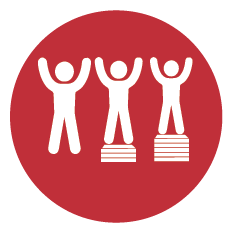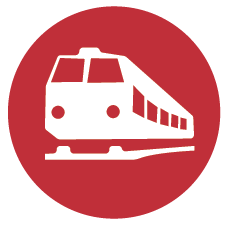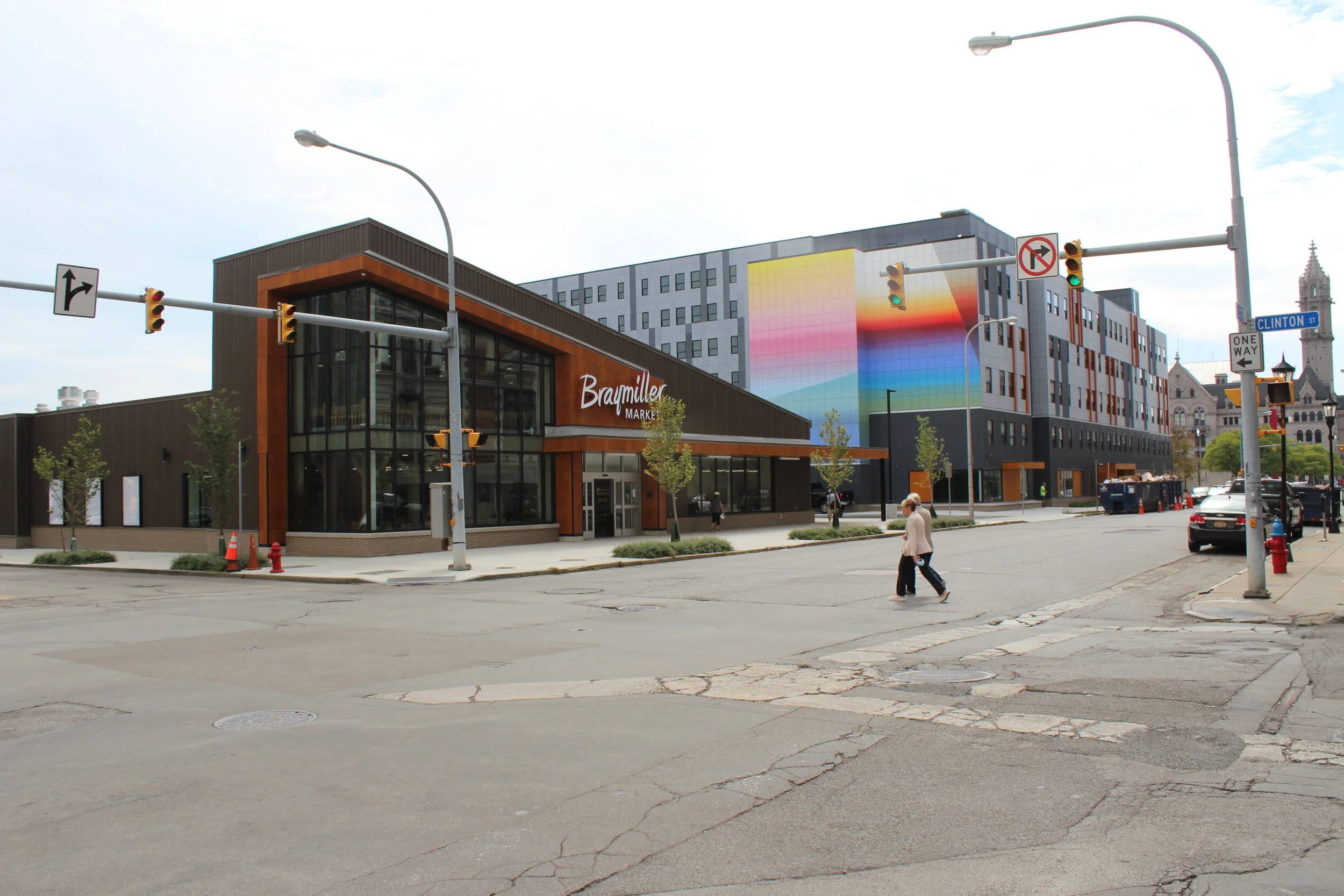What is Transit-Oriented Development?
Transit-Oriented Development, or TOD, is an approach to development that focuses land uses around a transit station or within a transit corridor. Typically, it is characterized by:
A mix of uses
Moderate to high density
Pedestrian orientation/connectivity
Transportation choices
Reduced parking
High quality design
TOD occurs within one-quarter mile, or a five to seven minute walk of a transit station.
Why Transit-Oriented Development?
What if you could get to the places that are most important to you without the headache and expense of driving?
TOD makes that lifestyle a reality.
By developing around transit, we are able to encourage and increase connectivity and help the Buffalo Niagara Region be more equitable and resilient.
Click on the icons below to learn more about each topic
 Closer to Equity
Closer to Equity
Equitable transit-oriented development (TOD) provides the benefits of access, mobility, employment, entrepreneurship, housing, and economic development that come along with TOD to everyone. Good TOD projects seek to embrace and empower the local community by building human capital and reversing the forces of socio-economic disinvestment.
Developing equitable, mixed-use, vibrant communities around transit will help the Buffalo-Niagara region sustain itself in the long-term. Business-as-usual approaches to development and growth often result in sprawl which diminishes the ability of developments to complement each other and create a critical mass of activity and employment opportunities that is accessible by means other than a personal vehicle. By encouraging the concentration of growth and development near transit, TOD strategies can ensure that even limited increases in population and employment over the coming decades in the Buffalo-Niagara region can be self-reinforcing and contribute to goals of economic vibrancy, equity, and upward mobility.
GBNRTC and NFTA are conducting a housing assessment, including household vulnerability to displacement and opportunities and challenges for affordable housing development along the Metro Rail corridor. The results of this analysis will set the stage for a Regional TOD fund that provides financing opportunities along the corridor for affordable housing and community facilities.
• Empower the local community through engaged participation
• Prioritize investments that bridge socio-economic gaps in underinvested communities
• Create and retain mixed-income housing
 Closer to Transit
Closer to Transit
The Niagara Frontier Transportation Authority is planning an expansion of the Metro Rail light-rail transit system from the City of Buffalo to the Northtowns. The expansion would extend Metro Rail service from its current terminus at University Station to the towns of Amherst and Tonawanda. The expansion would double the length of Metro Rail service and provide transit connections to places like University at Buffalo North Campus, Audubon, and commercial and retail activity along Maple Road and Niagara Falls Boulevard. Ten stations are proposed providing transit accessibility to new neighborhoods, with expanded connectivity throughout the region.
Transit-oriented development in its very nature, seeks to develop walkable, mixed-use, and mixed-income neighborhoods that are located close to transit. The region’s investment in Metro Rail will be a significant investment in the future of our region’s mobility. TOD looks to leverage this investment to provide equitable access to transit and bring housing, jobs, and essential services close to transit in order to improve livability and support a stronger link between places of importance and transit. Thus, supporting a stronger link between land use and transportation.
Visit the Metro Rail Expansion project website for more details: nftametrorailexpansion.com
• Improve mobility across region
• Enhance pedestrian experience within TOD corridor
• Increase development surrounding transit
 Closer to Opportunity
Closer to Opportunity
TOD creates neighborhoods that are vibrant, making them a desirable and comfortable place where people want to be, with the ability to improve the overall quality of life of residents in the Buffalo-Niagara Region. According to the Center for Transit Oriented Development, the demand for transit adjacent housing will nearly triple in the next twenty years. Moreover, the largest growing populations, singles, couples without children, the elderly, and low-income households, are more likely to seek affordable and mixed-income housing choices located in vibrant neighborhoods near transit.
Health
Along with TOD, comes enhanced access and mobility between housing, employment, education, training, and essential services (like healthcare and food). Increased access will help to reduce auto dependency and encourage mobility through public transit or active forms of transportation. This will be beneficial for the physical and financial health of residents by encouraging a more active and healthier lifestyle and reducing the amount households spend on transportation costs.
Place-making and Community
Promoting TOD along the existing and future Metro Rail corridor will help the Buffalo-Niagara Region grow a sustainable economy that can compete with peer cities in attracting and retaining population, jobs, and workforce, and ultimately creating opportunity. Regional economic competitiveness will be supported by leveraging private investment. Further, this development aims to empower communities within the region by embracing the people who live and work in these neighborhoods to create transit-supportive communities that serve their needs and support existing community anchors. This involves place-making approaches to maintain and invest in the social and culturally significant elements of a neighborhood. Equitable and inclusive public engagement and dialogue with community leaders and organizations will be necessary to provide guidance, understanding, and trust.
As part of the Comprehensive Transit-Oriented Development planning efforts, GBNRTC and NFTA will strategize ways to improve the land use-transportation linkage and leverage funding and financing tools to facilitate more TOD throughout the region.
• Increase access to jobs, housing, and education
• Reduce transportation costs
• Encourage sustainable growth
• Encourage healthy lifestyle
• Develop vibrant places and neighborhoods
• Empower communities
HELP US GET CLOSER.
You can help us discover what opportunities TOD should shape in the Buffalo-Niagara region by providing your input. For example, what constitutes a successful TOD? What amenities will promote place-making and equity? Do you have a business or neighborhood group that could benefit from a discussion on equitable TOD? Leave us a comment below.






